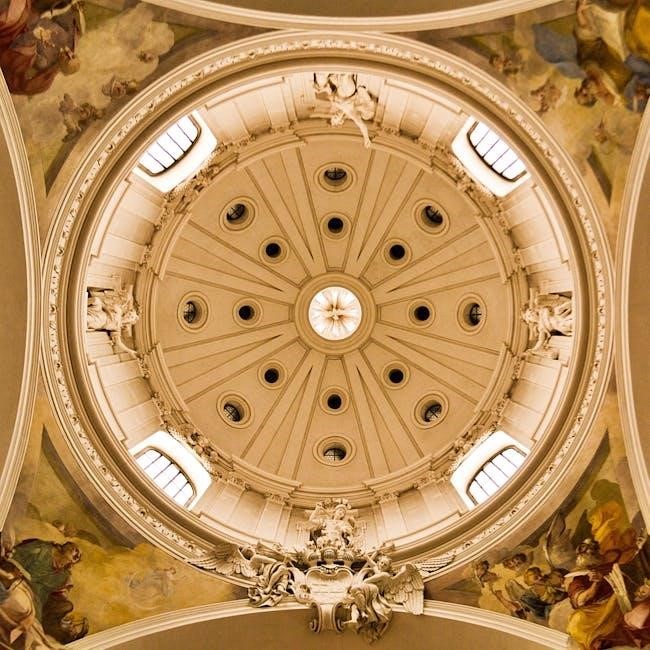guido reni st michael the archangel
Guido Reni’s St. Michael the Archangel is a captivating Baroque masterpiece depicting the archangel’s triumph over Satan. Created in 1635, it embodies the struggle between light and darkness, showcasing Reni’s artistic brilliance and spiritual depth.
Overview of the Painting
Guido Reni’s St. Michael the Archangel is a dramatic oil on canvas painting created in 1635. It vividly depicts the archangel Michael defeating Satan, showcasing a dynamic composition with intense movement. The painting is characterized by its Baroque style, with rich colors and chiaroscuro effects that heighten the emotional tension. St. Michael is portrayed in gleaming armor and a flowing cloak, symbolizing divine authority and protection, while Satan is depicted as a monstrous figure beneath his feet. The painting is housed in the Church of Santa Maria della Concezione dei Cappuccini in Rome, where it continues to inspire awe for its artistic mastery and spiritual significance. Reni’s work captures the eternal struggle between good and evil, embodying both power and elegance.
Historical Context of the Work
Guido Reni’s St. Michael the Archangel was created in 1635, a period of significant religious and artistic transformation in Rome. Commissioned by Cardinal Antonio Barberini, a prominent figure in the Catholic Church, the painting reflects the Counter-Reformation’s emphasis on reinforcing Catholic doctrine through art. The Barberini family, influential patrons, sought to promote spiritual devotion and counter Protestantism. Reni’s work aligns with the Baroque movement’s dramatic and emotive style, which flourished under papal patronage. The painting also draws inspiration from earlier artistic traditions, blending classical ideals with the intense realism of Caravaggisti. Set against the backdrop of religious turmoil, St. Michael the Archangel became a powerful symbol of divine protection and triumph over evil, resonating deeply with the spiritual and political climate of 17th-century Rome. Its creation underscores the intersection of faith, art, and patronage during this pivotal era.
The Commission and Creation
Guido Reni was commissioned by Cardinal Antonio Barberini to create St. Michael the Archangel for the Capuchin Church in Rome, reflecting the cardinal’s religious and artistic influence during the Baroque era.
Cardinal Antonio Barberini’s Role
Cardinal Antonio Barberini, brother of Pope Urban VIII, played a pivotal role in commissioning St. Michael the Archangel for the Capuchin Church in Rome. A prominent patron of the arts and theology, Barberini sought to promote Catholic doctrine through visual representation. His influence extended beyond finance, as he likely guided the painting’s thematic direction, emphasizing Michael as a protector of the faith. Barberini’s support of Reni reflects his admiration for the artist’s ability to convey divine themes with emotional depth. This collaboration underscored the cardinal’s commitment to Counter-Reformation ideals, using art to inspire devotion and reinforce Catholic identity. His involvement ensured the painting’s grandeur and theological significance, aligning with the Baroque era’s dramatic and symbolic style.
The Church of Santa Maria della Concezione dei Cappuccini
The Church of Santa Maria della Concezione dei Cappuccini in Rome was the intended home for Guido Reni’s St. Michael the Archangel. This Capuchin church, known for its austere yet profound spirituality, provided a fitting setting for the painting’s themes of divine triumph and moral struggle. The Capuchin order, emphasizing simplicity and devotion, likely influenced the artwork’s emotional and theological depth. Reni’s masterpiece was displayed prominently, serving as a visual testament to the archangel’s role as a celestial protector. The church’s association with the painting underscores its importance in 17th-century Catholic art and devotion, aligning with the Counter-Reformation’s emphasis on vivid religious imagery. Today, the painting remains a central element in the church’s spiritual and artistic heritage, inspiring reflection and awe among visitors. Its presence continues to resonate with the Capuchin ideals of faith and redemption.
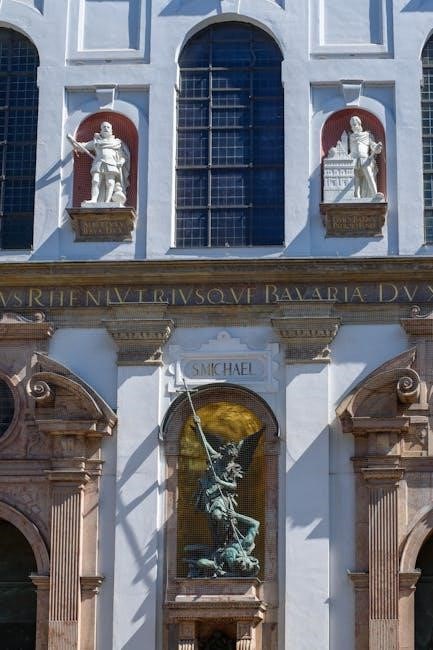
Artistic Style and Technique
Guido Reni’s St. Michael the Archangel showcases his mastery of Baroque art, blending dynamic composition, dramatic chiaroscuro, and vibrant color contrasts to create a awe-inspiring visual experience.
Baroque Elements in the Painting
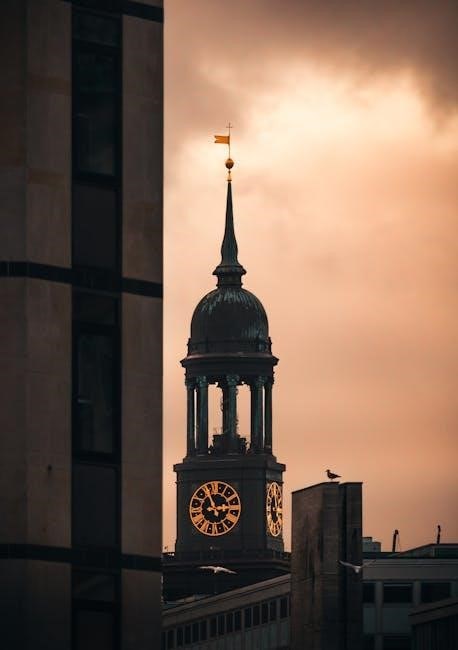
Guido Reni’s St. Michael the Archangel exemplifies Baroque art through its dramatic intensity and emotional depth. The painting features strong chiaroscuro, with intense light and dark contrasts that heighten the scene’s tension. The dynamic pose of St. Michael, poised in mid-action, and the dramatic drapery of his garments emphasize movement and energy. The vivid colors and theatrical composition create a sense of awe, drawing the viewer into the celestial battle. These elements, characteristic of the Baroque style, convey the power and divine authority of the archangel, while also evoking a sense of spiritual struggle and triumph. The painting’s dramatic and emotive qualities make it a quintessential Baroque work.
Use of Color and Composition
Reni’s masterful use of color and composition in St. Michael the Archangel creates a visually striking and emotionally engaging scene. The palette is dominated by warm, golden hues that evoke divine light, contrasting with darker tones to emphasize the struggle between good and evil. St. Michael, clad in shimmering armor, stands out against the somber background, drawing the viewer’s eye upward. The composition is balanced yet dynamic, with diagonal lines suggesting movement and energy. The archangel’s outstretched wings and the flowing drapery add a sense of fluidity, while the fallen Satan in the shadows creates depth and narrative tension. Reni’s meticulous attention to color harmony and spatial arrangement enhances the painting’s dramatic impact, making it a standout example of Baroque artistry.
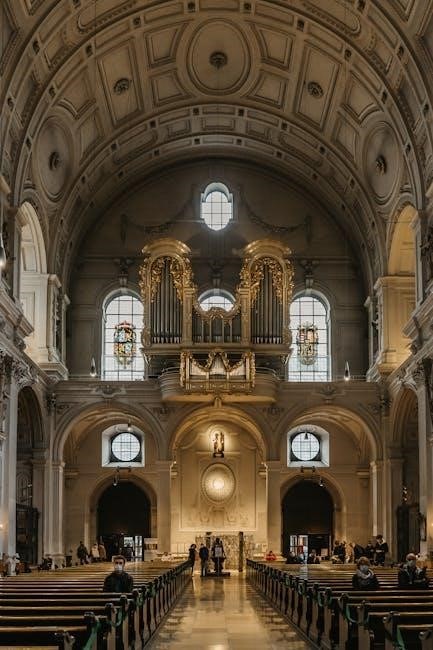
Symbolism and Iconography
St. Michael the Archangel symbolizes divine justice and protection, while Satan embodies evil. The painting’s iconography highlights the triumph of light over darkness, with Michael’s scales and sword signifying justice and divine authority. The contrasting colors and poses underscore the spiritual battle, reinforcing the archangel’s role as a protector of faith and humanity.
Archangel Michael as a Protector
In Guido Reni’s St. Michael the Archangel, the archangel is depicted as a powerful protector, embodying divine justice and strength. His armor and sword symbolize his role as a defender of faith and humanity. The painting captures Michael’s triumphant stance over Satan, representing his guardianship against evil forces. Reni’s portrayal emphasizes Michael’s celestial authority, with his scales and heavenly cloak signifying purity and righteousness. This imagery reinforces the archangel’s historical significance as a protector in religious traditions, evoking themes of hope and resilience. The artwork serves as a visual testament to Michael’s enduring role as a divine guardian, inspiring awe and devotion in those who behold it.
The Depiction of Satan
In Guido Reni’s St. Michael the Archangel, Satan is depicted as a defeated, grotesque figure, symbolizing evil and chaos. Reni’s portrayal emphasizes the dramatic contrast between light and darkness, with Satan’s dark, twisted form starkly opposing the radiant archangel. The painting captures Satan’s subjugation, highlighting his powerlessness against divine authority. Reni’s use of shadows and dim lighting underscores Satan’s malevolent nature, while his contorted expression conveys suffering and defiance. This depiction reinforces the theological narrative of good triumphing over evil, with Satan serving as a visual representation of the forces Michael is tasked to vanquish. The artwork’s dramatic tension and emotional intensity are heightened by this vivid portrayal of the adversary.
Cultural and Religious Significance
Guido Reni’s St. Michael the Archangel holds profound religious and cultural significance, reflecting devotion to the archangel as a protector and symbol of divine triumph over evil.
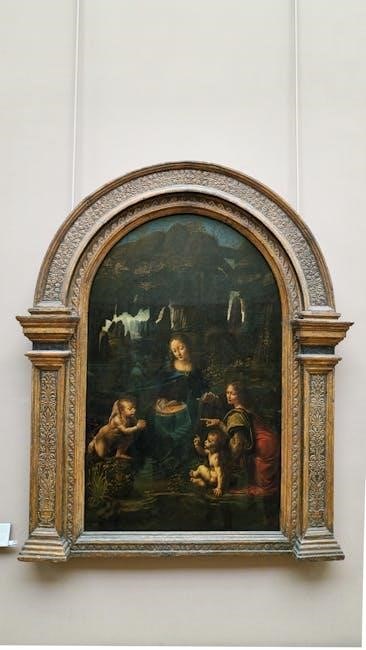
The Painting’s Message and Impact
Guido Reni’s St. Michael the Archangel delivers a powerful message of divine triumph over evil, resonating deeply with its religious audience. The vivid depiction of Michael defeating Satan symbolizes the eternal struggle between light and darkness, inspiring hope and faith. Reni’s masterful use of color and composition amplifies the emotional impact, drawing viewers into the spiritual drama. The painting became a cultural icon, reflecting the Baroque era’s emphasis on dramatic religious art. Its influence extended beyond the church, shaping artistic and devotional practices. Today, it remains a testament to Reni’s brilliance and the enduring appeal of religious art in conveying universal themes of redemption and protection.
Guido Reni’s Legacy
Guido Reni’s St. Michael the Archangel solidified his reputation as a master of Baroque painting, blending elegance with dramatic intensity. His work influenced countless artists, shaping the development of religious and mythological art. Reni’s ability to convey emotion through color and composition elevated his status as a leading figure in Bolognese painting. This painting, in particular, exemplifies his artistic philosophy, balancing harmony and dynamism. Reni’s legacy endures as a testament to his innovative style, which continues to inspire admiration and study. His contributions to art remain timeless, ensuring his place as one of the most celebrated painters of the 17th century. Reni’s work is not only a reflection of his era but also a enduring celebration of artistic excellence and spiritual expression.
